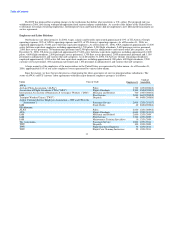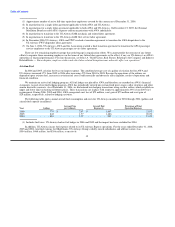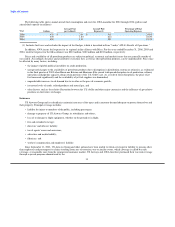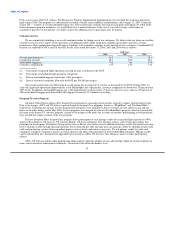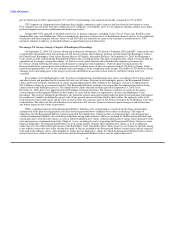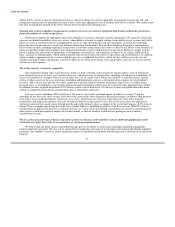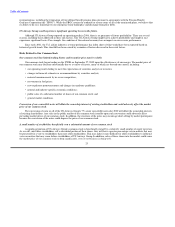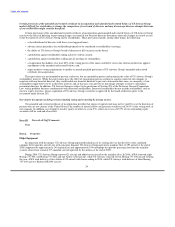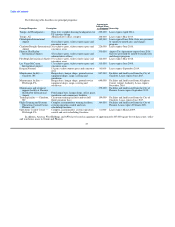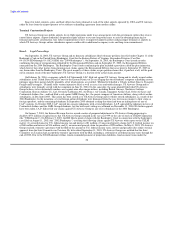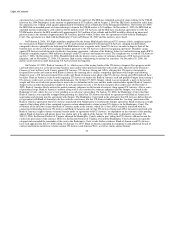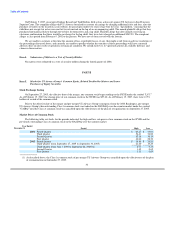US Airways 2006 Annual Report Download - page 23
Download and view the complete annual report
Please find page 23 of the 2006 US Airways annual report below. You can navigate through the pages in the report by either clicking on the pages listed below, or by using the keyword search tool below to find specific information within the annual report.
Table of Contents
commitments to purchase or lease them. If for any reason we were unable to secure deliveries of new aircraft on contractually scheduled
delivery dates, this could have a negative impact on our business, operations and financial performance. Our failure to integrate newly
purchased aircraft into our fleet as planned might require us to seek extensions of the terms for some leased aircraft. Such unanticipated
extensions may require us to operate existing aircraft beyond the point of which it is economically optimal to retire them, resulting in
increased maintenance costs. Additionally, there has been a recent increase in aircraft lease rates. If new aircraft orders are not filled on a
timely basis, we could face higher monthly rental rates.
Fluctuations in interest rates could adversely affect our liquidity, operating expenses and results.
A substantial portion of our indebtedness bears interest at fluctuating interest rates. These are primarily based on the London
interbank offered rate for deposits of U.S. dollars, or LIBOR. LIBOR tends to fluctuate based on general economic conditions, general
interest rates, federal reserve rates and the supply of and demand for credit in the London interbank market. We have not hedged our
interest rate exposure and, accordingly, our interest expense for any particular period may fluctuate based on LIBOR and other variable
interest rates. To the extent these interest rates increase, our interest expense will increase, in which event we may have difficulties
making interest payments and funding our other fixed costs, and our available cash flow for general corporate requirements may be
adversely affected. See also the discussion of interest rate risk in Part II, Item 7A.
If we incur problems with any of our third party service providers, our operations could be adversely affected by a resulting decline in
revenue or negative public perception about our services.
Our reliance upon others to provide essential services on behalf of our operations may result in the relative inability to control the
efficiency and timeliness of contract services. We have entered into agreements with contractors to provide various facilities and services
required for our operations, including Express operations, aircraft maintenance, ground facilities, reservations and baggage handling.
Similar agreements may be entered into in any new markets we decide to serve. These agreements are generally subject to termination
after notice by the third party service provider. Any material problems with the efficiency and timeliness of contract services could have a
material adverse effect on our business, financial condition and results of operations.
Increases in insurance costs or reductions in insurance coverage may adversely impact our operations and financial results.
The terrorist attacks of September 11, 2001 led to a significant increase in insurance premiums and a decrease in the insurance
coverage available to commercial air carriers. Accordingly, our insurance costs increased significantly and our ability to continue to
obtain insurance even at current prices remains uncertain. In addition, we have obtained third party war risk (terrorism) insurance through
a special program administered by the FAA, resulting in lower premiums than if we had obtained this insurance in the commercial
insurance market. The program has been extended, with the same conditions and premiums, until August 31, 2007. Under Vision 100, the
President may continue the insurance program until March 30, 2008. If the federal insurance program terminates, we would likely face a
material increase in the cost of war risk insurance. Because of competitive pressures in our industry, our ability to pass additional
insurance costs to passengers is limited. As a result, further increases in insurance costs or reductions in available insurance coverage
could have an adverse impact on our financial results.
Changes in government regulation could increase our operating costs and limit our ability to conduct our business.
Airlines are subject to extensive regulatory requirements. In the last several years, Congress has passed laws, and the Department of
Transportation, the FAA, the Transportation Security Administration and the Department of Homeland Security have issued a number of
directives and other regulations. These requirements impose substantial costs on airlines. The FAA has proposed a far-reaching set of
rules governing flight operations at New York LaGuardia Airport after January 1, 2007. The new rules could result in dramatic changes
to the type and number of services that we offer in the future at LaGuardia. Additional laws, regulations, taxes and airport rates and
charges have been proposed or discussed from time to time, including recent discussions about a "passenger bill of rights," and if adopted
these could significantly increase the cost of airline operations or reduce revenues. The
20



